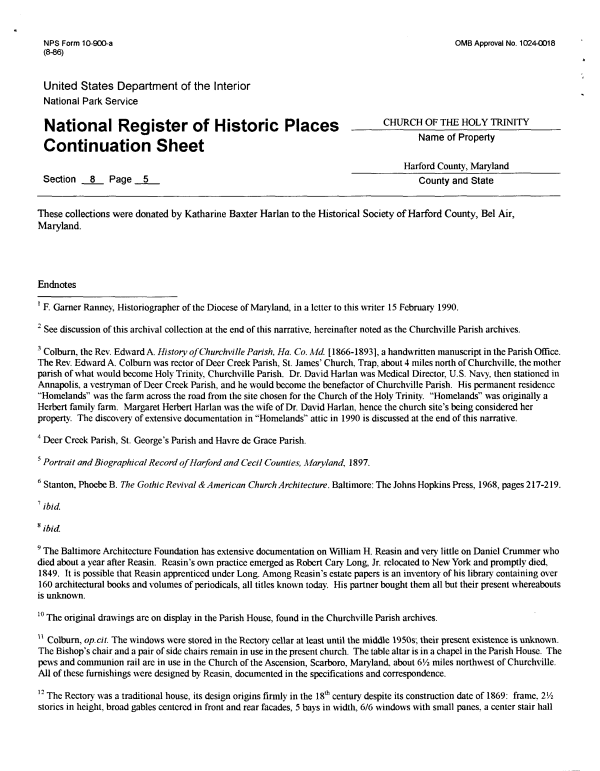 |
||||
|
DEPARTMENT OF HOUSING AND COMMUNITY DEVELOPMENT, MARYLAND HISTORICAL TRUST (Historic Sites Survey) var.d. MSA SE16-8 Image No: se16-8-0359 Enlarge and print image (64K) |
 |
||||
|
DEPARTMENT OF HOUSING AND COMMUNITY DEVELOPMENT, MARYLAND HISTORICAL TRUST (Historic Sites Survey) var.d. MSA SE16-8 Image No: se16-8-0359 Enlarge and print image (64K) |
| NFS Form 1O-900-a OMB Approval No. 1024-0018 (8-86) United States Department of the Interior National Park Service National Register Of Historic Places CHURCH OF THE HOLY TRINITY -^ A. .. f+. < Name of Property Continuation Sheet Harford County, Maryland Section 8 Page 5 County and State These collections were donated by Katharine Baxter Harlan to the Historical Society of Harford County, Bel Air, Maryland. Endnotes 1 F. Garner Ranney, Historiographer of the Diocese of Maryland, in a letter to this writer 15 February 1990. 2 See discussion of this archival collection at the end of this narrative, hereinafter noted as the Churchville Parish archives. 3 Colburn, the Rev. Edward A. History of Churchville Parish, Ha. Co. Md. [1866-1893], a handwritten manuscript in the Parish Office. The Rev. Edward A. Colburn was rector of Deer Creek Parish, St. James' Church, Trap, about 4 miles north of Churchville, the mother parish of what would become Holy Trinity, Churchville Parish. Dr. David Harlan was Medical Director, U.S. Navy, then stationed in Annapolis, a vestryman of Deer Creek Parish, and he would become the benefactor of Churchville Parish. His permanent residence "Homelands" was the farm across the road from the site chosen for the Church of the Holy Trinity. "Homelands" was originally a Herbert family farm. Margaret Herbert Harlan was the wife of Dr. David Harlan, hence the church site's being considered her property. The discovery of extensive documentation in "Homelands" attic in 1990 is discussed at the end of this narrative. 4 Deer Creek Parish, St. George's Parish and Havre de Grace Parish. 5 Portrait and Biographical Record of Harford and Cecil Counties, Maryland, 1897. 6 Stanton, Phoebe B. The Gothic Revival & American Church Architecture. Baltimore: The Johns Hopkins Press, 1968, pages 217-219. 1 ibid. 8 ibid 9 The Baltimore Architecture Foundation has extensive documentation on William H. Reasin and very little on Daniel Crummer who died about a year after Reasin. Reasin's own practice emerged as Robert Gary Long, Jr. relocated to New York and promptly died, 1849. It is possible that Reasin apprenticed under Long. Among Reasin's estate papers is an inventory of his library containing over 160 architectural books and volumes of periodicals, all titles known today. His partner bought them all but their present whereabouts is unknown. 10 The original drawings are on display in the Parish House, found in the Churchville Parish archives. u Colburn, op.cit. The windows were stored in the Rectory cellar at least until the middle 1950s; their present existence is unknown. The Bishop's chair and a pair of side chairs remain in use in the present church. The table altar is in a chapel in the Parish House. The pews and communion rail are in use in the Church of the Ascension, Scarboro, Maryland, about 6!/z miles northwest of Churchville. All of these furnishings were designed by Reasin, documented in the specifications and correspondence. 12 The Rectory was a traditional house, its design origins firmly in the 18th century despite its construction date of 1869: frame, 2'/2 stories in height, broad gables centered in front and rear facades, 5 bays in width, 6/6 windows with small panes, a center stair hall |